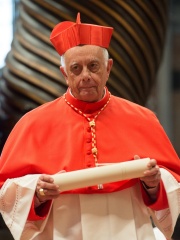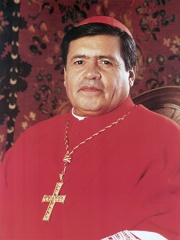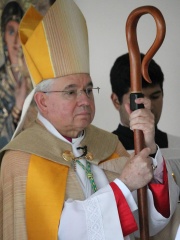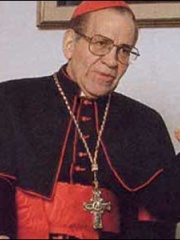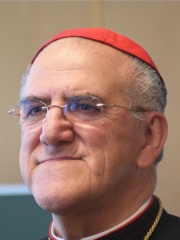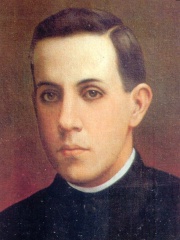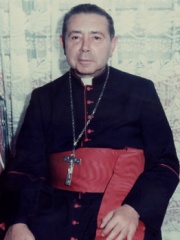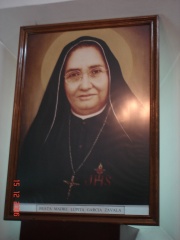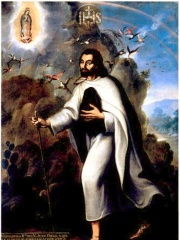
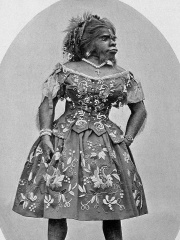
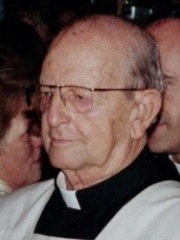
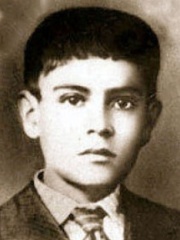
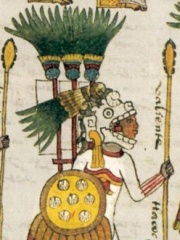
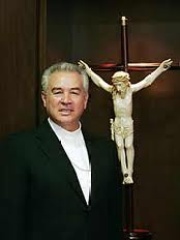
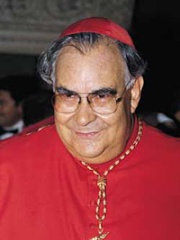
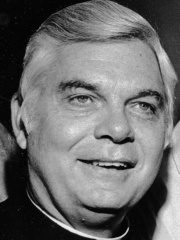
The Most Famous
RELIGIOUS FIGURES from Mexico
This page contains a list of the greatest Mexican Religious Figures. The pantheon dataset contains 3,187 Religious Figures, 19 of which were born in Mexico. This makes Mexico the birth place of the 29th most number of Religious Figures behind Netherlands, and Hungary.
Top 10
The following people are considered by Pantheon to be the top 10 most legendary Mexican Religious Figures of all time. This list of famous Mexican Religious Figures is sorted by HPI (Historical Popularity Index), a metric that aggregates information on a biography's online popularity. Visit the rankings page to view the entire list of Mexican Religious Figures.

1. Juan Diego (1474 - 1548)
With an HPI of 67.71, Juan Diego is the most famous Mexican Religious Figure. His biography has been translated into 27 different languages on wikipedia.
Juan Diego Cuauhtlatoatzin (1474–1548), also known simply as Juan Diego (Spanish pronunciation: [ˌxwanˈdjeɣo]), was a Nahua peasant and Marian visionary. He is said to have been granted apparitions of Our Lady of Guadalupe on four occasions in December 1531: three at the hill of Tepeyac and a fourth before don Juan de Zumárraga, then the first bishop of Mexico. The Basilica of Our Lady of Guadalupe, located at the foot of Tepeyac, houses the cloak (tilmahtli) that is traditionally said to be Juan Diego's, and upon which the image of the Virgin is said to have been miraculously impressed as proof of the authenticity of the apparitions. Juan Diego's visions and the imparting of the miraculous image, as recounted in oral and written colonial sources such as the Huei tlamahuiçoltica, are together known as the Guadalupe event (Spanish: el acontecimiento Guadalupano), and are the basis of the veneration of Our Lady of Guadalupe. This veneration is ubiquitous in Mexico, prevalent throughout the Spanish-speaking Americas, and increasingly widespread beyond. As a result, the Basilica of Our Lady of Guadalupe is now one of the world's major Christian pilgrimage destinations, receiving 22 million visitors in 2010. Juan Diego is the first Catholic saint indigenous to the Americas. He was beatified in 1990 and canonized in 2002 by Pope John Paul II, who on both occasions traveled to Mexico City to preside over the ceremonies.

2. Julia Pastrana (1834 - 1860)
With an HPI of 64.64, Julia Pastrana is the 2nd most famous Mexican Religious Figure. Her biography has been translated into 30 different languages.
Julia Pastrana (August 1834 – 25 March 1860) was a performer and singer during the 19th century who had hypertrichosis. Pastrana, an indigenous woman from Mexico, was born in 1834, somewhere in the state of Sinaloa. She was born with a genetic condition, hypertrichosis terminalis (or generalized hypertrichosis lanuginosa); her face and body were covered with straight black hair. Her ears and nose were unusually large, and her teeth were irregular. The latter condition was caused by a rare disease, undiagnosed in her lifetime, gingival hyperplasia, which thickened her lips and gums.

3. Marcial Maciel (1920 - 2008)
With an HPI of 63.87, Marcial Maciel is the 3rd most famous Mexican Religious Figure. His biography has been translated into 15 different languages.
Marcial Maciel Degollado (March 10, 1920 – January 30, 2008) was a Mexican Catholic priest and sex offender. Maciel founded the Legion of Christ and the Regnum Christi movement. He was general director of the Legion from 1941 to 2005. Throughout most of his career, he was respected within the church as "the greatest fundraiser of the modern Roman Catholic church" and as a prolific recruiter of new seminarians. Late in his life, Maciel was revealed to have been a longtime drug addict who sexually abused at least 60 boys and young men in his care. After his death, it came to light that he had also maintained sexual relationships with at least four women, one of whom was a minor at the time. He fathered as many as six children, two of whom he is alleged to have sexually abused. In 2006, Pope Benedict XVI removed Maciel from active ministry, based on the results of an investigation by the Congregation for the Doctrine of the Faith in April 2005. Maciel was ordered "to conduct a reserved life of prayer and penance, renouncing every public ministry". He died in 2008. On March 25, 2010, a communiqué on the Legion's website acknowledged as factual the "reprehensible actions" by Maciel, including sexual abuse of minor seminarians. In May 2010, the Vatican denounced Maciel's actions and appointed a Papal Delegate to oversee the order and its governance.

4. José Sánchez del Río (1913 - 1928)
With an HPI of 63.26, José Sánchez del Río is the 4th most famous Mexican Religious Figure. His biography has been translated into 18 different languages.
José Luis Sánchez del Río (March 28, 1913 – February 10, 1928) was a Mexican Cristero who was put to death by government officials because he refused to renounce his Catholic faith. His death was seen as a largely political venture on the part of government officials in their attempt to stamp out dissent and crush religious freedom in the area. He was dubbed "Joselito". He was declared to be venerable on June 22, 2004, by Pope John Paul II and was beatified by Pope Benedict XVI – through the Cardinal-Prefect of the Congregation of the Causes of Saints – on November 20, 2005, in Mexico. Pope Francis approved a miracle attributed to him on January 21, 2016, allowing for his canonization to take place; a date was determined at a consistory on March 15, 2016, and he was canonized a saint on October 16, 2016.
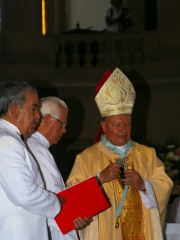
5. Juan Sandoval Íñiguez (b. 1933)
With an HPI of 61.26, Juan Sandoval Íñiguez is the 5th most famous Mexican Religious Figure. His biography has been translated into 23 different languages.
Juan Sandoval Íñiguez (Spanish pronunciation: [xwan sandoˈβal ˈiɲiɣes]; born 28 March 1933) is a Mexican retired prelate of the Catholic Church who served as the Archbishop of Guadalajara from 1994 to 2011. He was made a cardinal by Pope John Paul II in 1994.

6. Tlacaelel (1397 - 1487)
With an HPI of 61.07, Tlacaelel is the 6th most famous Mexican Religious Figure. His biography has been translated into 19 different languages.
Tlacaelel I (1397 – 1487) (Classical Nahuatl: Tlācaēllel Nahuatl pronunciation: [t͡ɬaːkaˈeːlːel], "Man of Strong Emotions," from "tlācatl," person and "ēllelli," strong emotion) was the principal architect of the Aztec Triple Alliance and hence the Mexica (Aztec) empire. He was the son of Emperor Huitzilihuitl and Queen Cacamacihuatl, nephew of Emperor Itzcoatl, father of poet Macuilxochitzin, and brother of Emperors Chimalpopoca and Moctezuma I. During the reign of his uncle Itzcoatl, Tlacaelel was given the office of Tlacochcalcatl, but during the war against the Tepanecs in the late 1420s, he was promoted to first adviser to the ruler, a position called Cihuacoatl in Nahuatl, an office that Tlacaelel held during the reigns of four consecutive Tlatoque, until his death in 1487. Tlacaelel recast or strengthened the concept of the Aztecs as a chosen people, elevated the tribal god/hero Huitzilopochtli to top of the pantheon of gods, and increased militarism. In tandem with this, Tlacaelel is said to have increased the level and prevalence of human sacrifice, particularly during a period of natural disasters that started in 1446 (according to Diego Durán). Durán also states that it was during the reign of Moctezuma I, as an invention of Tlacaelel that the flower wars, in which the Aztecs fought Tlaxcala and other Nahuan city-states, were instigated. To strengthen the Aztec nobility, he helped create and enforce sumptuary laws, prohibiting commoners from wearing certain adornments such as lip plugs, gold armbands, and cotton cloaks. He also instigated a policy of burning the books of conquered peoples with the aim of erasing all memories of a pre-Aztec past. When he dedicated the seventh reconstruction of the Templo Mayor in Tenochtitlan, Tlacaelel had brought his nation to the height of its power. The dedication took place in 1484 and was celebrated with the sacrifice of many war captives. After Tlacaelel's death in 1487, the Mexica Empire continued to expand north into the Gran Chichimeca and south toward the Maya lands.

7. Francisco Robles Ortega (b. 1949)
With an HPI of 60.90, Francisco Robles Ortega is the 7th most famous Mexican Religious Figure. His biography has been translated into 24 different languages.
Francisco Robles Ortega (Spanish pronunciation: [fɾanˈsisko ˈro.βles oɾˈteɣa]; born 2 March 1949) is a Mexican prelate of the Catholic Church who has been Archbishop of Guadalajara since 2012 and a cardinal since 2007. He was archbishop of Monterrey from 2003 to 2011. He was president of the Mexican Episcopal Conference from 2012 to 2018.

8. Juan Jesús Posadas Ocampo (1926 - 1993)
With an HPI of 60.36, Juan Jesús Posadas Ocampo is the 8th most famous Mexican Religious Figure. His biography has been translated into 19 different languages.
Juan Jesús Posadas Ocampo (11 November 1926 – 24 May 1993) was an archbishop of the Catholic Church in Mexico who served as the eighth archbishop of the see of Guadalajara and as a cardinal of the Roman Catholic Church. Posadas Ocampo was elevated to the cardinalate by Pope John Paul II on the consistory of 28 June 1991. On 24 May 1993, Cardinal Posadas was murdered, struck by 14 bullets during a shootout at Miguel Hidalgo y Costilla Guadalajara International Airport. Officially, Mexican-American sicarios were carrying out a contract killing for the Tijuana Cartel when Cardinal Posadas was allegedly mistaken for rival Sinaloa Cartel drug lord Joaquín "El Chapo" Guzmán. Allegations have continued to be investigated, however, that the Cardinal was actually murdered by the Mexican Government in order to cover up collusion between Mexican drug cartels and human trafficking rings and senior politicians during Mexico's 90-year long government of the Institutional Revolutionary Party (PRI).

9. Bernard Francis Law (1931 - 2017)
With an HPI of 60.30, Bernard Francis Law is the 9th most famous Mexican Religious Figure. His biography has been translated into 24 different languages.
Bernard Francis Cardinal Law (November 4, 1931 – December 20, 2017) was a Mexican-born American prelate of the Catholic Church who, among other offices, served as Archbishop of Boston from 1984 to 2002. Originally considered an influential voice among American Catholic hierarchy and the wider Boston society as a supporter of church orthodoxy and social justice, along with his work in ecumenism and civil rights, his image was dramatically changed after the 2002 exposé of his involvement in covering up the serial rape of children by Catholic priests, which led to his resignation as Archbishop of Boston in December of that year. Prior to that office, Law served as Bishop of Springfield–Cape Girardeau from 1973 to 1984. He also served as Cardinal Priest of Santa Susanna from 1985 to his death in 2017, and as archpriest of the Basilica di Santa Maria Maggiore from 2004 to 2011, these being largely ceremonial roles. Law was Archbishop of Boston from March 1984 until his resignation on December 13, 2002, after his involvement in the Archdiocese of Boston sex abuse scandal became public knowledge. Law was proven to have ignored or concealed the molestation of many underage children; Church documents demonstrate that he had extensive knowledge of widespread child sexual abuse committed by dozens of Catholic priests in his archdiocese over almost two decades; he failed to report these crimes to the authorities, instead merely transferring the accused priests between parishes. One priest in Law's archdiocese, John Geoghan, raped or molested more than 130 children in six different parishes in a career of 30 years. Law was widely denounced for his handling of the sexual abuse cases, and outside the church his public image was destroyed in the aftermath of the scandal. Two years after Law resigned from his position in Boston, which Bishop William Skylstad called "an important step in the healing process", Pope John Paul II appointed him Archpriest of the Basilica di Santa Maria Maggiore in Rome in 2004. He resigned the position upon reaching age 80 in November 2011, and died in Rome on December 20, 2017, at age 86.
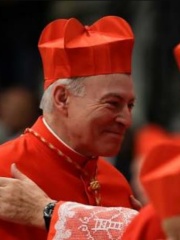
10. Carlos Aguiar Retes (b. 1950)
With an HPI of 60.24, Carlos Aguiar Retes is the 10th most famous Mexican Religious Figure. His biography has been translated into 21 different languages.
Carlos Aguiar Retes (Spanish pronunciation: [ˈkaɾlos aˈɣjaɾ ˈretes]; born 9 January 1950) is a Mexican cardinal of the Catholic Church who serves as the Archbishop of Mexico City. He has served as an officer of the Mexican Episcopal Conference and the Latin American Episcopal Conference (CELAM) and been president of both. He helped draft the landmark mission statement CELAM issued at the close of its 2007 conference in Aparecida. He was archbishop of Tlalnepantla from 2009 to 2017 and Bishop of Texcoco from 1997 to 2009. David Agren of the Catholic News Service calls him a "longtime ally" of Pope Francis who combines "intellectual finesse with a pastoral passion".
People
Pantheon has 19 people classified as Mexican religious figures born between 1397 and 1951. Of these 19, 6 (31.58%) of them are still alive today. The most famous living Mexican religious figures include Juan Sandoval Íñiguez, Francisco Robles Ortega, and Carlos Aguiar Retes. The most famous deceased Mexican religious figures include Juan Diego, Julia Pastrana, and Marcial Maciel.
Living Mexican Religious Figures
Go to all RankingsJuan Sandoval Íñiguez
1933 - Present
HPI: 61.26
Francisco Robles Ortega
1949 - Present
HPI: 60.90
Carlos Aguiar Retes
1950 - Present
HPI: 60.24
Alberto Suárez Inda
1939 - Present
HPI: 58.58
Norberto Rivera Carrera
1942 - Present
HPI: 57.88
José Horacio Gómez
1951 - Present
HPI: 50.50
Deceased Mexican Religious Figures
Go to all RankingsJuan Diego
1474 - 1548
HPI: 67.71
Julia Pastrana
1834 - 1860
HPI: 64.64
Marcial Maciel
1920 - 2008
HPI: 63.87
José Sánchez del Río
1913 - 1928
HPI: 63.26
Tlacaelel
1397 - 1487
HPI: 61.07
Juan Jesús Posadas Ocampo
1926 - 1993
HPI: 60.36
Bernard Francis Law
1931 - 2017
HPI: 60.30
Adolfo Suárez Rivera
1927 - 2008
HPI: 60.17
Javier Lozano Barragán
1933 - 2022
HPI: 59.15
Miguel Pro
1891 - 1927
HPI: 58.29
Ernesto Corripio y Ahumada
1919 - 2008
HPI: 55.25
María Guadalupe García Zavala
1878 - 1963
HPI: 54.61
Overlapping Lives
Which Religious Figures were alive at the same time? This visualization shows the lifespans of the 10 most globally memorable Religious Figures since 1700.

